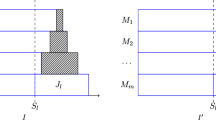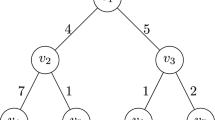Abstract
In this paper, we provide a family of bounds for the rate at which the functions of many inputs can be computed in-network on general topologies. Going beyond simple symmetric functions where the output is invariant to the permutation of the operands, e.g., average, parity, we describe an algorithm that is analyzed to provide throughput bounds (both lower and upper) for the general functions. In particular, we analyze our algorithm when the function to be computed is given as a binary tree schema. Our lower bounds depend on schema parameters like the number of operands and graph parameters like the second largest eigenvalue of the transition matrix of simple random walk on network graph, the maximum and minimum degree of any node in the network. The lower bounding technique that we have used is based on the network flows and can capture general multi-commodity flow settings. Our proposed algorithm uses the well-known simple random walk on a network as its basic primitive for routing. We show that the lower bound obtained on the rate of computation is tight for the complete network topology, the hypercube and the star topology. We also present an upper bound on the expected latency of any data operand in terms of the height of schema, well-studied random walk parameter like the hitting time, and the relative distance from the critical data rate. For the computation time of symmetric functions on the random geometric graph under the gossip model, our approach achieves an order-optimal \(\widetilde{O}(n)\) time despite enforcing a binary tree schema for function computation. In general, Big-O notation represents an upper bound and \(\widetilde{O}\) hides \(\text {poly}\log n\) factors.


Similar content being viewed by others
References
Aldous, D., Fill, J.: Reversible markov chains and random walks on graphs (2002)
Aqeel-ur, R., Abbasi, A.Z., Islam, N., Shaikh, Z.A.: A review of wireless sensors and networks’ applications in agriculture. Comp. Stand. Interfaces 36(2), 263–270 (2014)
Ayaso, O., Shah, D., Dahleh, M.A.: Information theoretic bounds for distributed computation over networks of point-to-point channels. IEEE Trans. Inf. Theory 56(12), 6020–039 (2010)
Banerjee, S., Gupta, P., Shakkottai, S.: Towards a queueing-based framework for in-network function computation. Queueing Syst. 72(3), 219–250 (2012)
Becchetti, L., Bonifaci, V., Natale, E.: Pooling or sampling: Collective dynamics for electrical flow estimation. In: Proc. of the 17th International Conference on Autonomous Agents and Multi Agent Systems, AAMAS ’18, pp. 1576–1584 (2018)
Bénézit, F., Dimakis, A.G., Thiran, P., Vetterli, M.: Order-optimal consensus through randomized path averaging. IEEE Trans. Inform Theory 56(10), 5150–5167 (2010)
Boyd, S., Ghosh, A., Prabhakar, B., Shah, D.: Gossip algorithms: design, analysis and applications. In: Proceedings of the 24th annual joint conference of the IEEE computer and communications societies, INFOCOM ’05, vol. 3, pp. 1653–1664. IEEE (2005)
Christiano, P., Kelner, J.A., Madry, A., Spielman, D.A., Teng, S.H.: Electrical flows, Laplacian systems, and faster approximation of maximum flow in undirected graphs. In: Proceedings of the 43rd annual ACM Symposium on theory of computing, STOC ’11, pp. 273–282. ACM (2011)
Dimakis, A.D.G., Sarwate, A.D., Wainwright, M.J.: Geographic gossip: efficient averaging for sensor networks. IEEE Trans. Signal Process. 56(3), 1205–1216 (2008)
Dutta, C., Radhakrishnan, J.: Lower bounds for noisy wireless networks using sampling algorithms. In: Proceedings of 49th annual IEEE symposium on foundations of computer science, FOCS ’08, pp. 394–402. IEEE (2008)
Georgiadis, L., Szpankowski, W.: Stability of token passing rings. Queueing Syst. 11(1–2), 7–33 (1992)
Gillani, I.A., Bagchi, A.: A queueing network-based distributed Laplacian solver for directed graphs. Inf. Proc. Lett. (2021). https://doi.org/10.1016/j.ipl.2020.106040
Gillani, I.A., Bagchi, A., Ranu, S.: A group-to-group version of random walk betweenness centrality. In: Proceedings of 8th ACM IKDD CODS and 26th COMAD, CODS-COMAD ’21 (2021). https://doi.org/10.1145/3430984.3431020
Gillani, I.A., Bagchi, A., Vyavahare, P.: Decentralized random walk-based data collection in networks (2017). ArXiv:1701.05296v4 [cs.NI]
Gillani, I.A., Bagchi, A., Vyavahare, P.: A stochastic process on a network with connections to Laplacian systems of equations (2017). ArXiv:1701.05296 [cs.NI]
Giridhar, A., Kumar, P.R.: Computing and communicating functions over sensor networks. IEEE J. Sel. Area. Comm. 23(4), 755–764 (2005)
Gross, D.: Fundamentals of Queueing Theory. Wiley, New York (2008)
Intanagonwiwat, C., Govindan, R., Estrin, D., Heidemann, J., Silva, F.: Directed diffusion for wireless sensor networking. IEEE/ACM Trans. Netw. 11(1), 2–16 (2003)
Jawad, H., Nordin, R., Gharghan, S., Jawad, A., Ismail, M.: Energy-efficient wireless sensor networks for precision agriculture: a review. Sensors 17(8), 1781 (2017)
Jones, N.M., Paschos, G.S., Shrader, B., Modiano, E.: An overlay architecture for throughput optimal multipath routing. IEEE/ACM Trans. Netw. 25(5), 2615–2628 (2017)
Kamath, S., Manjunath, D., Mazumdar, R.: On distributed function computation in structure-free random wireless networks. IEEE Trans. on Inform. Theory 60(1), 432–442 (2014)
Kamra, A., Misra, V., Feldman, J., Rubenstein, D.: Growth codes: maximizing sensor network data persistence. In: Proceedings of the 2006 Conference on applications, technologies, architectures, and protocols for computer communications, SIGCOMM ’06, pp. 255–266. ACM (2006)
Kannan, S., Viswanath, P.: Multi-session function computation and multicasting in undirected graphs. IEEE J. Sel. Area. Comm. 31(4), 702–713 (2013)
Karamchandani, N., Appuswamy, R., Franceschetti, M.: Time and energy complexity of function computation over networks. IEEE Trans. Inf. Theory 57(12), 7671–7684 (2011)
Kelner, J.A., Lee, Y.T., Orecchia, L., Sidford, A.: An almost-linear-time algorithm for approximate max flow in undirected graphs, and its multicommodity generalizations. In: Proceedings of the 25th annual ACM-SIAM Symposium on discrete algorithms, SODA ’14, pp. 217–226. SIAM (2014)
Leighton, T., Rao, S.: Multicommodity max-flow min-cut theorems and their use in designing approximation algorithms. J. ACM 46(6), 787–832 (1999)
Levin, D.A., Peres, Y., Wilmer, E.L.: Markov chains and mixing times. American Mathematical Soc. (2009)
Liu, J., Xia, C.H., Shroff, N.B., Zhang, X.: On distributed computation rate optimization for deploying cloud computing programming frameworks. SIGMETRICS Perform. Eval. Rev. 40(4), 63–72 (2013)
Loynes, R.M.: The stability of a queue with non-independent inter-arrival and service times. In: Mathematical Proceedings of the Cambridge philosophical society, vol. 58, pp. 497–520. Cambridge University Press (1962)
Lu, Z., Wen, Y., Fan, R., Tan, S.L., Biswas, J.J.: Toward efficient distributed algorithms for in-network binary operator tree placement in wireless sensor networks. IEEE J. Sel. Area. Comm. 31(4), 743–755 (2013)
Luo, W., Ephremides, A.: Stability of \(N\) interacting queues in random-access systems. IEEE Trans. Info. Theory 45(5), 1579–1587 (1999)
Mosk-Aoyama, D., Shah, D.: Computing separable functions via gossip. In: Proceedings of the 25th annual ACM symposium on principles of distributed computing, PODC ’06, pp. 113–122. ACM (2006)
Ndzi, D.L., Harun, A., Ramli, F.M., Kamarudin, M.L., Zakaria, A., Shakaff, A.Y.M., Jaafar, M.N., Zhou, S., Farook, R.S.: Wireless sensor network coverage measurement and planning in mixed crop farming. Comput. Electr. Agric. 105, 83–94 (2014)
Pandurangan, G., Robinson, P., Scquizzato, M.: Distributed complexity of large-scale graph computations. In: Proceedings of the 30th ACM symposium on parallelism and architectures, SPAA ’18, pp. 405–414. ACM (2018)
Sefidgaran, M., Tchamkerten, A.: Distributed function computation over a rooted directed tree. IEEE Trans. Inf. Theory 62(12), 7135–7152 (2016)
Shah, D.: Network gossip algorithms. In: Proceedings of the IEEE international conference on acoustics, speech and signal processing, ICASSP ’09, pp. 3673–3676. IEEE (2009)
Shah, V., Dey, B.K., Manjunath, D.: Network flows for function computation. IEEE J. Sel. Area. Comm. 31(4), 714–730 (2013)
Sinclair, A.: Algorithms for random generation and counting. Progress in theoretical computer science (1993)
Szpankowski, W.: Stability conditions for some distributed systems: Buffered random access systems. Adv. Appl. Prob. 26(2), 498–515 (1994)
Von Luxburg, U., Radl, A., Hein, M.: Hitting and commute times in large random neighborhood graphs. J. Mach. Learn. Res. 15(1), 1751–1798 (2014)
Vyavahare, P., Limaye, N., Manjunath, D.: Optimal embedding of functions for in-network computation: complexity analysis and algorithms. IEEE/ACM Trans. Netw. 24(4), 2019–2032 (2016)
Wang, G., Wang, Z., Wu, J.: A local average broadcast gossip algorithm for fast global consensus over graphs. J Parallel Distrib. Comput. 109, 301–309 (2017)
Xu, A., Raginsky, M.: Information-theoretic lower bounds for distributed function computation. IEEE Trans. Inf. Theory 63(4), 2314–2337 (2017)
Author information
Authors and Affiliations
Corresponding author
Additional information
Publisher's Note
Springer Nature remains neutral with regard to jurisdictional claims in published maps and institutional affiliations.
Rights and permissions
About this article
Cite this article
Gillani, I.A., Vyavahare, P. & Bagchi, A. Lower bounds for in-network computation of arbitrary functions. Distrib. Comput. 34, 181–193 (2021). https://doi.org/10.1007/s00446-021-00394-7
Received:
Accepted:
Published:
Issue Date:
DOI: https://doi.org/10.1007/s00446-021-00394-7




